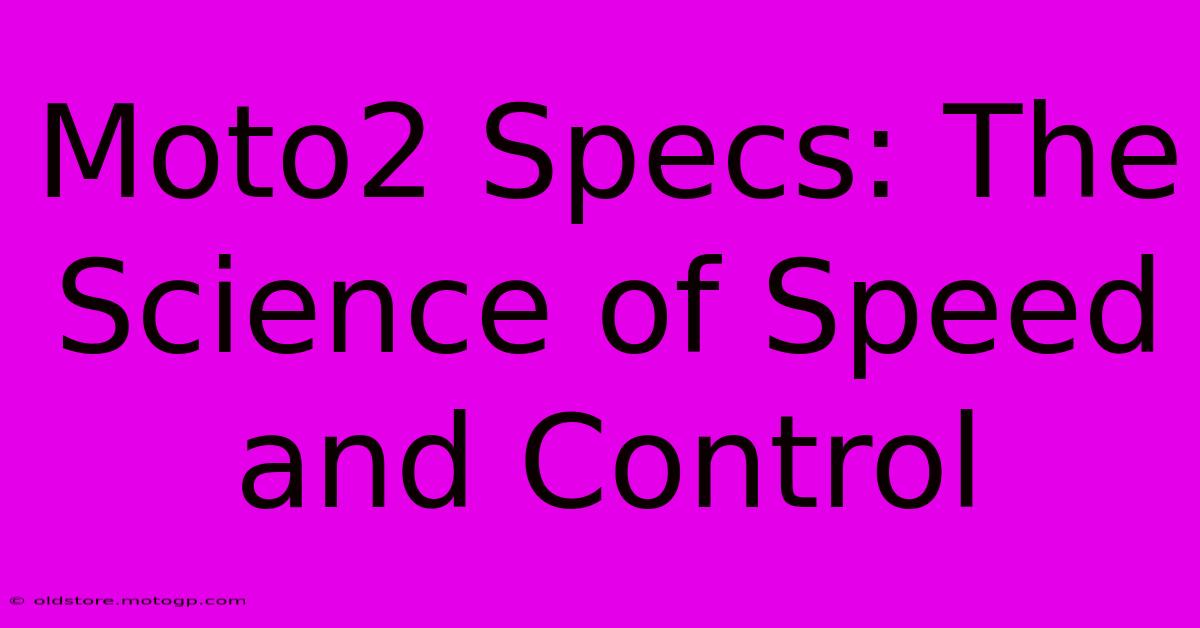Moto2 Specs: The Science Of Speed And Control

Table of Contents
Moto2 Specs: The Science of Speed and Control
The Moto2 class in Grand Prix motorcycle racing represents a fascinating blend of cutting-edge technology and stringent regulations. Unlike MotoGP, where manufacturers compete with bespoke machines, Moto2 utilizes a single engine supplier, ensuring a level playing field focused on rider skill and chassis development. This standardized engine, however, doesn't diminish the complexity or excitement of the class; instead, it highlights the intricate science of speed and control within a tightly defined set of specifications.
The Heart of the Beast: The Triumph 765cc Triple Engine
The backbone of every Moto2 machine is the Triumph 765cc inline-triple engine, a refined and powerful unit derived from the Street Triple RS. This choice represents a significant departure from previous engine suppliers, introducing a characterful engine with exceptional performance characteristics.
Key Engine Specs and Performance:
- Displacement: 765cc
- Configuration: Inline-three-cylinder
- Fuel Injection: Electronic fuel injection
- Power Output: Around 140bhp (exact figures are closely guarded)
- Torque: Significant torque delivery across the rev range, crucial for acceleration out of corners.
- Transmission: Six-speed seamless gearbox – crucial for maintaining momentum during races.
The engine's characteristics—smooth power delivery and strong torque—are carefully balanced to make the machine challenging yet rewarding to ride, emphasizing rider skill and finesse.
Chassis Dynamics: A Symphony of Suspension and Geometry
While the engine is standardized, teams have considerable freedom in chassis design and setup. This allows for a wide range of approaches to handling and performance, leading to diverse riding styles and strategic advantages.
Key Chassis Components and Their Impact:
- Frame: Teams employ various materials and designs (aluminum is common) to optimize rigidity and weight distribution. The frame's stiffness directly impacts handling characteristics, influencing how the bike responds to rider input.
- Suspension: Fully adjustable front and rear suspension systems (typically Öhlins) allow for fine-tuning to suit different track conditions and rider preferences. Precise suspension settings are crucial for optimizing grip and stability.
- Brakes: High-performance braking systems are essential for effective deceleration, particularly crucial in Moto2's fast-paced corners. The choice of calipers, discs, and master cylinder significantly impacts stopping power and feel.
- Tires: Teams work closely with tire supplier Dunlop to select optimal tire compounds and pressures depending on the track surface and weather conditions. Tire choice can dramatically affect grip, acceleration, and cornering speeds.
The optimization of these chassis components forms the foundation of a bike's handling, influencing its responsiveness, stability, and overall performance. Teams constantly experiment with different setups, aiming to find the perfect balance between agility and stability.
Aerodynamics: The Unsung Hero of Speed
Aerodynamics play a surprisingly significant role in Moto2 performance. Although less pronounced than in MotoGP, aerodynamic efficiency impacts top speed and stability, particularly at high speeds.
Importance of Aerodynamic Design:
- Fairings: The design of the fairings influences airflow around the bike, minimizing drag and maximizing downforce. Teams will test various fairing designs to optimize aerodynamic performance.
- Wind Tunnel Testing: Wind tunnel testing is essential to refine aerodynamic design. This allows teams to analyze airflow and make adjustments to maximize efficiency and stability.
The Rider Factor: The Human Element
While technology is crucial, the rider remains the most critical component of Moto2 success. The intense physical demands and finely honed skills required underscore the mastery needed to extract maximum performance from these complex machines.
Rider Skills and Fitness:
- Precise Control: The rider's ability to smoothly control the throttle, brakes, and suspension is essential for maintaining consistent lap times.
- Physical Fitness: Moto2 racing demands exceptional physical fitness, as riders endure intense G-forces and extreme physical exertion throughout the race.
- Strategic Awareness: Racers must possess racecraft skills, including strategic overtaking maneuvers and defensive riding techniques.
Conclusion: A Perfect Harmony
The Moto2 class showcases a remarkable balance between technological innovation and rider skill. The standardized engine ensures a fair competition, emphasizing the importance of chassis development, aerodynamic optimization, and the exceptional capabilities of the riders. This blend of science, engineering, and athleticism makes Moto2 a truly captivating spectacle, showcasing the pinnacle of intermediate-class motorcycle racing.

Thank you for visiting our website wich cover about Moto2 Specs: The Science Of Speed And Control. We hope the information provided has been useful to you. Feel free to contact us if you have any questions or need further assistance. See you next time and dont miss to bookmark.
Featured Posts
-
Find Your Limit Circuit Of The Americas Track Day
Feb 22, 2025
-
Cota Grounds Pass The Perfect Addition To Your Race Trip
Feb 22, 2025
-
Fast Cars Fast Track Cota Open Track Days
Feb 22, 2025
-
Formula 1 Parking Dont Let Parking Ruin Your Day
Feb 22, 2025
-
F1 Event Houston Your Ultimate Guide
Feb 22, 2025
